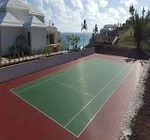Tennis court flooring plays a critical role in how the game is played, the safety of players, and the court's long-term durability. Whether you're installing a court for residential, commercial, or sports facility use, selecting the right flooring type is essential. This guide explores various types of tennis court flooring, key materials, performance benefits, cost considerations, and maintenance tips to help you make an informed decision.
1. Types of Tennis Court Flooring
There are four main types of tennis court surfaces, each offering a unique playing experience:
1.1. Hard Court (Acrylic Flooring)
Material: Concrete or asphalt base coated with acrylic layers
Bounce Speed: Medium to fast
Maintenance: Low to moderate
Lifespan: 4–8 years (depending on usage and climate)
Pros:
- Consistent bounce and speed
- Suitable for all playing styles
- UV- and weather-resistant
- Customizable color and surface texture
Cons:
- Can be hard on joints
- Requires resurfacing every few years
1.2. Clay Court
Material: Crushed brick, shale, or stone
Bounce Speed: Slow
Maintenance: High
Lifespan: Ongoing with regular upkeep
Pros:
- Slower pace encourages longer rallies
- Softer on joints
- Preferred for training and skill development
Cons:
- Needs daily maintenance (watering, rolling)
- Not ideal for high-rainfall regions
1.3. Grass Court
Material: Natural grass over compacted soil
Bounce Speed: Fast and low
Maintenance: Very high
Lifespan: Seasonal
Pros:
- Traditional, classic tennis experience
- Soft surface reduces injury risk
Cons:
- Expensive to maintain
- Weather-dependent usability
- Surface deteriorates quickly with use
1.4. Synthetic/Artificial Turf
Material: Polypropylene or polyethylene fibers over rubber or sand infill
Bounce Speed: Medium
Maintenance: Low to moderate
Lifespan: 7–12 years
Pros:
- Good for multipurpose sports flooring
- Aesthetically pleasing
- Easier to install and maintain than grass
Cons:
- Can become slippery when wet
- May require infill top-up
2. Factors to Consider When Choosing Flooring
Choosing the right tennis court surface depends on various factors:
2.1. Usage Purpose
- Professional/Club Level: Hard or clay courts
- School & Recreational Use: Synthetic turf or acrylic
- Backyard Courts: Cushioned acrylic or synthetic options
2.2. Climate and Weather
- Wet climates: Avoid grass and clay
- Hot climates: Use UV-resistant acrylic
- Cold climates: Consider frost-resistant sub-base materials
2.3. Player Type
- Beginners benefit from slower surfaces like clay
- Professionals often prefer faster acrylic or grass
- Older players may favor cushioned surfaces for joint support
2.4. Budget
- Low Budget: Synthetic turf
- Mid Budget: Acrylic hard courts
- High Budget: Grass or high-performance cushioned acrylic
3. Installation Process
Step-by-Step Overview:
- Site Preparation: Leveling, drainage system setup
- Sub-base Construction: Crushed stone or asphalt base
- Surface Layer Application:
- For acrylic: Multiple coats of primer, filler, color, and texture layers
- For turf: Laying turf, adding infill
- Court Marking: White lines for singles and doubles
- Accessories Installation: Nets, posts, fencing, lighting (if required)
4. Cost of Tennis Court Flooring (India & Globally)
Surface TypeApprox. Cost (INR/sq.ft)Approx. Cost (USD/sq.ft)Acrylic₹120 – ₹180$1.5 – $2.5Clay₹100 – ₹150$1.3 – $2.0Synthetic₹90 – ₹140$1.1 – $1.9Grass₹200 – ₹300$2.5 – $4.0
Note: Prices vary based on location, material brand, and customization.
5. Maintenance Tips by Flooring Type
SurfaceDaily MaintenanceAnnual TasksAcrylicSweep debris, wash surfaceResurface every 4–5 yearsClayWater, roll, sweep dailyReapply clay, level surfaceSyntheticBrush fibers, check infillAdd infill, disinfect periodicallyGrassMow regularly, waterReseed, aerate, top dress
6. Emerging Trends in Tennis Court Flooring
- Cushioned Acrylic Systems: Reduces player fatigue and injury risk
- Modular Tiles: Interlocking polypropylene tiles ideal for DIY or temporary courts
- Eco-Friendly Materials: Recycled rubber bases and water-saving clay courts
- LED Integration: Lighting solutions embedded into court flooring
7. Recommended Brands & Installers in India
Some of the top brands and vendors in India for tennis court flooring include:
- Pacecourt
- Advanced Acrylic Layer
- DecoTurf
- GreenFloor
- Gameflooring
- TennisFlooring.com (Your brand – include contact CTA)
8. Conclusion
Tennis court flooring is more than just aesthetics—it defines the pace, safety, and longevity of your court. Whether you're building for personal use or a professional setup, invest in quality materials, skilled installation, and regular maintenance to maximize your return and performance.


